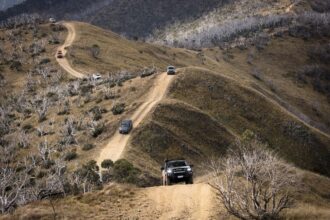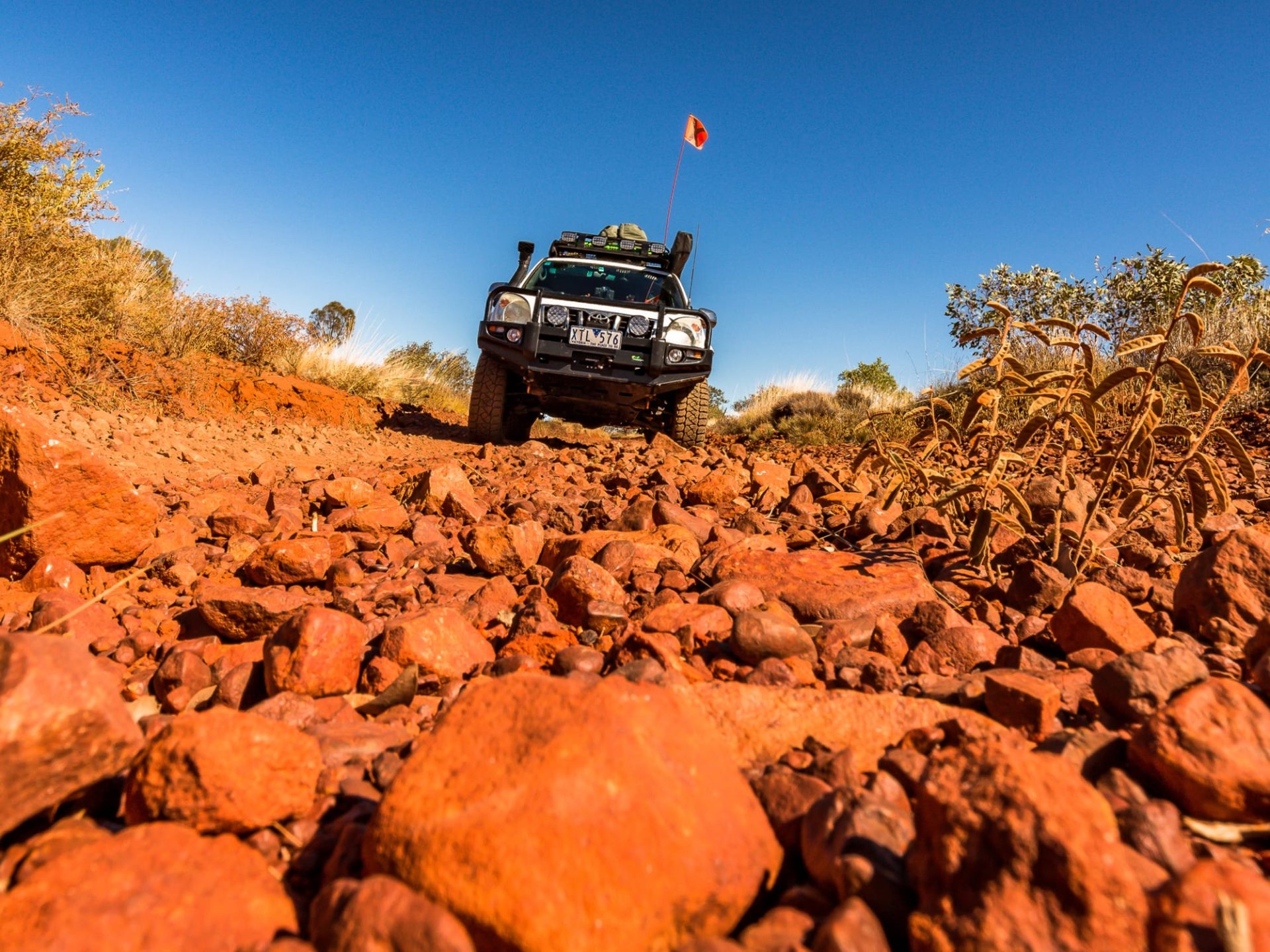Sometimes you make decisions in life that are absolute failures… but if you have fun on the way, who bloody cares?
When it comes to travelling the Outback, there are times when I have made somewhat poor decisions that caused some consternation. Only once did I think I would lose my truck, and never have I put anyone in danger. Today I misread a map and it turned into four hours of vehicle and camper trailer recovery. Hindsight was wonderful, but hell we had some fun.
We departed Kings Canyon Resort, excited with the day’s plan to head to Palm Valley via Boggy Hole in the Finke River National Park. I knew that it wasn’t recommended to tow camper trailers along the route, but I had built the camper for a purpose and this was one of them. We backtracked to Ernest Giles Road, stopping to scavenge for wood when we could.
Watching my Hema map closely as I crossed a cattle grid, I missed what I thought was the track we needed (even though it wasn’t signposted). A quick U-turn and radio consult and Craig in his Jeep and Rod and Andre in the Colorado followed me down the thin, sandy track towards the Palmer River. Tyre pressures were dropped, mine down to 20 PSI all around. Driving onto the river flood plain, I was bogged instantaneously and the fun began.
The Palmer River became our Wall of the North. We just couldn’t get everything across. The camper was the hindrance – it just plugged into the sand, tyre pressures dropped to bugger-all, with the weight of the wood on the A-frame not helping at all. Bogged, dig, snatch, bogged, dig, Treds, snatch, bogged, dig, Treds, snatch, bogged.
We spent a good couple of hours trying to get me across. The Colorado was a champion, and the Jeep was parked a safe distance away. Eventually, the trailer was unhitched in the middle of the river… my clutch blowing black smoke was a bad sign. Once free of the burden, both the Colorado and my Prado made it across to the opposite bank with a minimum of fuss.
The job now was to get back across and recover the camper trailer. We hooked up the winch to the rear recovery points on the camper using a bridle and upended a Tred to use as a ski for the jockey wheel. The camper was dragged up onto the sandbank, then snatched 90 degrees before being hitched onto the Colorado. We didn’t want to risk my clutch again. Rod readied himself, then put the right boot to the floor – tearing across the river and along the flood plain and not stopping until he was clear of the soft sand and up on higher ground.
We returned to Kings Canyon Resort, tails between our legs, sunburnt and exhausted. None of us had the desire to cook so we trundled up to the Thirsty Dingo Bar (and we were thirsty) and enjoyed a few quiet ales and some great Outback tucker. Tomorrow is another day.
Next morning, we packed a bit slower than normal before fuelling up and heading off. We followed the bitumen of Larapinta Drive, climbing up to Morris Pass. A stop at the lookout provided us with inspiring views across the plains and ranges. There were a few fire pits scattered around the lookout. It’s a free campsite often used by backpackers as it is still on the bitumen.
The bitumen ends on the other side of the hill, and the corrugations start. With tyre pressures reduced a bit more the ride was improved. Take your time and soak up the magnificent vistas along the Mereenie Loop.
The stunning Gosse Bluff grows as you near the junction with Namatjira Drive. Bitumen will reach here within weeks as the move to make this area more accessible gains momentum. We continued along Larapinta Drive until just before Hermannsburg, following the signs at the turnoff to Palm Valley. We stopped to air down a little more. The track into Palm Valley is rated as high-clearance 4WD only as it traverses sections of the Finke River. As we were parked, five or six soft-roaders drove past… raising a few eyebrows. We encountered the soft-roaders at the first Finke River crossing, parked up so the passengers could enjoy the water (not game to go any further). The track into the campground had been graded three months prior, so it was a nice drive in. The Finke had been flowing prior to this (an amazing moment I have yet to experience). The roughest section was at the electronic gate that was set up to prevent the wild brumbies from entering the National Park.
Our timing was perfect in arriving at the campground. The overnighters had all packed up and left, leaving us with good options for our chosen position. Once the site fees had been paid (bring exact change), we lit the fire. Coals would be needed for our spit-roast pork loin and roast vegies. As the aroma circulated around the campground – while the crackling crackled and the vegetables roasted – there was an abundance of mouth-watering as every camper checked out what we were cooking. This was one of the best bush roasts I have prepared in a long time, and in such a remarkable setting.
Next morning, we headed out to Palm Valley. A couple of backpackers joined our convoy; they were a bit nervous, having heard stories about the track rating. While a good challenge it’s simple enough if you drop into low range, proceed slowly and enjoy the scenic drive over the rocks. On reaching the carpark I felt that the track had been modified over the years, reducing the chances of panel damage that existed on my previous visits.
From the carpark, there are a couple of walking options that offer great views of the ancient Cabbage Palms and the valley. We chose the 5km Mpulungkinya Loop walk that took us high up onto the sandstone plateau above the palms and led us to views across Palm Paddock before we dropped down deeper into the valley. The Arankala walk is a shorter 2km walk along the valley floor and amongst the palms before a shorter climb up onto the plateau; and it then loops back to the carpark.
The Central Australian Red Cabbage Palms that dominate the valley are unique in that they are only found in and around the Finke Gorge National Park. Nourished by a large underground water source, the palms and other plants flourish. In 1993 scientists measured and counted 12,328 palms; however in 2008 this number had dropped to 9,037 palms. Scientists believe that a huge flood in 1988 may have helped spawn an unusually large number of seedlings prior to the 1993 survey. The tallest of the palms reach 25 metres and beyond, with the oldest palms thought to be between 100 and 300 years old.
Returning to camp for lunch, we decided to sneak a shower in the female toilets as the men’s showers were closed due to sewer issues. We did let the women in camp know beforehand, so as not to scare anyone. A discovery of the great use of modern technology is the Telstra mobile hotspot near the old Ranger’s station. It is as simple as placing your phone on a steel plate. Wait 30 seconds and your phone will start singing as messages and emails start flowing through. My wife was quite surprised to hear from me when I called. The old Ranger station was abandoned after it was inundated during the 1988 floods. The current Ranger station is further into the valley and located higher up.
The great setup of four BBQ plates and gas burners in the camp kitchen meant dinner was cooked (and the dishes washed) with ease. This allowed us plenty of time to relax by the fire on our last night in the bush before heading to Alice Springs in the morning.
Pack-up was simple after pancakes for breakfast. We stopped at the Kalarranga Lookout. This short climb offers up extraordinary panoramas of the remarkable weathered sandstone hills. I can recommend the Mpaara Walk that envelops you into the Aboriginal Dreamtime by following the story of Mpaara, the Tawny Frogmouth Man and the Pangkalanga Devil Man. We had run out of time to complete this challenging walk, but I have enjoyed the 5km loop walk with superb views on a previous visit.
As we exited the Finke Gorge National Park and hit the bitumen that led us all the way to the populous centre that is Alice Springs, I realised with sadness that my Outback adventure had reached the halfway mark and Craig and Andre would be heading home. But don’t worry; Rod and I still have a long way to go and will be visiting some epic destinations.
Destination Details:
Region: Finke Gorge National Park.
Nearest town: Alice Springs is 138km east via Larapinta Drive.
When to go: The cooler months from April to September are the best times, but the roads may close after heavy rain.
Accommodation: Finke Gorge National Park is remote bush camping at its best. Camping at Palm Valley costs $6.60 per person per night (and $3.30 per child over 5 years). There are flushing toilets, solar heated showers (when working), LPG BBQs and burners and communal fire pits. During peak times, Rangers hold informative talks around the campfire.
What to take: A compressor and tyre gauge, firewood, food and water. Take out what you take in (except wood, of course).
Difficulty: The 16km track into Palm Valley and campground can be accessed by high-clearance 4WD. The Finke River 4WD route is more remote; ensure your vehicle is well maintained and you are an experienced 4WD traveller. Carry extra food and water, vehicle equipment, recovery and safety gear.










